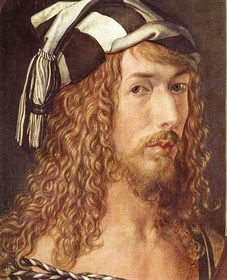Albrecht Dürer
 Albrecht Dürer (1471-1528) was a painter and printmaker, considered the greatest exponent of the German Renaissance. Born in Nuremberg by a Hungarian goldsmith, he had a brief apprenticeship in his father’s workshop, and completed his training at the workshops of M. Wolgemuth and H. Pleydenwurf between 1486 and 1490. He undertook trips and sojourns in Basel (1490-94) and in Italy (1494-95), which were fundamental for the development of his art before opening his own workshop in Nuremberg. In 1505, already an established artist, he returned to Venice, where he stayed for two years. Subsequently, he worked for various German clients such as the Elector of Saxony or the Dominicans in Frankfurt. From 1512 he entered the service of Emperor Maximilian I, who, since 1515, granted him an annual salary for life which was then confirmed by the emperor’s successor, his grandson Charles V. He died at Nuremberg. Within his vast production, in which there are many masterpieces, we recall various portraits and self-portraits, the 14 woodcuts of the Apocalypse, the monumental Four Apostles and three famous engravings of The Knight, Death and the Devil, Saint Jerome in his study, and especially, Melancholia I, full of references to esoteric and hermetic symbols.
Albrecht Dürer (1471-1528) was a painter and printmaker, considered the greatest exponent of the German Renaissance. Born in Nuremberg by a Hungarian goldsmith, he had a brief apprenticeship in his father’s workshop, and completed his training at the workshops of M. Wolgemuth and H. Pleydenwurf between 1486 and 1490. He undertook trips and sojourns in Basel (1490-94) and in Italy (1494-95), which were fundamental for the development of his art before opening his own workshop in Nuremberg. In 1505, already an established artist, he returned to Venice, where he stayed for two years. Subsequently, he worked for various German clients such as the Elector of Saxony or the Dominicans in Frankfurt. From 1512 he entered the service of Emperor Maximilian I, who, since 1515, granted him an annual salary for life which was then confirmed by the emperor’s successor, his grandson Charles V. He died at Nuremberg. Within his vast production, in which there are many masterpieces, we recall various portraits and self-portraits, the 14 woodcuts of the Apocalypse, the monumental Four Apostles and three famous engravings of The Knight, Death and the Devil, Saint Jerome in his study, and especially, Melancholia I, full of references to esoteric and hermetic symbols.
